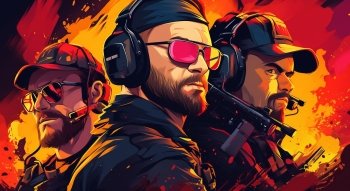Streaming on YouTube vs Twitch

So, you’ve finally decided to jump into the world of streaming — exciting, right? The chance to join the community of aspiring content creators is just too tempting to pass up. Well, it’s only natural to aim for the same level of success as your favorite streamers.
But here’s the thing—most top streamers today started in a different era when there was more room for trial and error. As a new streamer diving into this buzzing niche, you can’t afford to waste much time getting off the ground. It’s crucial to set your priorities and make key decisions, like choosing the right platform, from the get-go. That’s where we come in — we’re here to help you figure out how to stream CS2 and which platform suits you best.
Is it better to stream on Twitch or YouTube? Let’s break it down.
Twitch and YouTube: What’s the Difference?
Picking the right service for streamers is your foundational step as an up-and-coming content creator. You’ve got two heavyweights in front of you: Twitch vs YouTube live streaming platforms. Both of them have their own unique features and can open doors to serious growth — both personally and professionally. However, they cater to slightly different audiences that have evolved over the years.
If you dig deeper, you’ll find even more differences in Twitch vs YouTube. Understanding the ins and outs of each platform, such as unique traits, benefits, and flaws, will help you make the best informed, long-term decision for your streaming career.
We’ll guide you through this decision by comparing YouTube streaming vs Twitch on key points like target audiences (TAs), monetization options, user experience, and moderation. Let’s dive in.
User Interface and Streaming Quality
Twitch — For Real-Time Interactions & Focused Streaming
Twitch is the undisputed king among streaming platforms, with a setup tailored specifically for live interactions. Its minimalist interface is easy to get the hang of, especially if you’re already familiar with YouTube’s UI. The standard rightmost menu is similar to YouTube’s layout. Twitch offers customizable overlays, chat windows, real-time alerts, and stream schedules — everything you need to kick off your streaming journey right away.
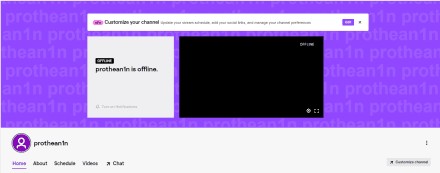
User Cabinet
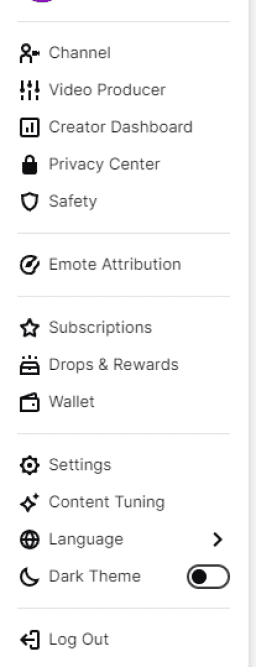
Rightmost Menu
When it comes to streaming properties, Twitch supports multiple resolutions, including 1080p at 60fps, ensuring smooth and high-quality streams. However, its lower bitrate cap compared to YouTube might slightly hold back video quality for viewers with high-resolution displays.
YouTube — For Long-Term Content & Resolution
Right off the bat, YouTube’s interface is more multifaceted, offering a broader range of video-sharing options but at the cost of being more complex. It takes a bit more time to figure out all the functions because YouTube is designed for a wider range of experiences. You’ve got separate dashboards for channel analytics, YouTube Studio, and tons of customizable settings.
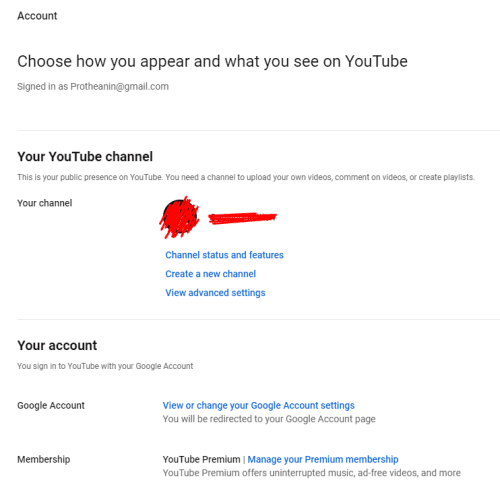
User Cabinet
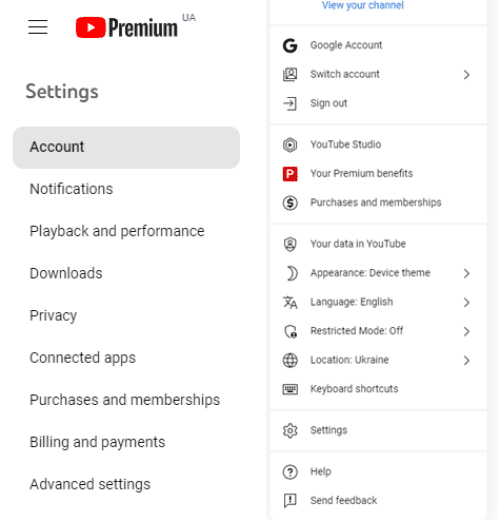
Leftmost / Rightmost Menus
Still, all the options are neatly organized, so with a little time and effort, you can easily navigate everything. Overall, YouTube's interface is less geared toward live interaction, which makes real-time streams feel less engaging. However, it excels in archiving and search capabilities, making it a standout in those areas.
When talking about Twitch vs YouTube streaming quality, keep in mind that the latter supports higher bitrates and up to 4K streaming, offering superior video quality compared to Twitch. Nonetheless, it’s essential to check whether your hardware can ensure such streaming quality without affecting in-game performance.
Audience and Popularity
Twitch — For Gamers and the “In-The-Know” Crowd
Twitch has carved out its niche as the go-to platform for gamers, with a community deeply rooted in the live-streaming culture. With over 240 million monthly active users, it’s heavily focused on gaming and eSports.
Twitch’s audience is highly interactive, with viewers diving into chats, subscribing to channels, and donating to their favorite streamers. However, this audience is also more niche, mainly made up of gaming enthusiasts, which can limit your reach if you’re creating non-gaming content.
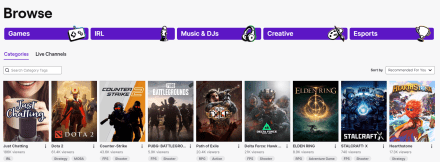
“Browse” Page of Twitch
YouTube — For Everyone
YouTube's audience is massive and diverse, with over 2.7 billion logged-in monthly users. The platform’s broader appeal stretches far beyond gaming, covering a wide range of content genres, such as vlogging, tutorials, music, and more.
For streamers, this means tapping into a wider, more varied audience. YouTube's search algorithm also boosts discoverability, giving new creators a better shot at reaching viewers outside of their immediate subscriber base. However, if you want to become truly popular on this platform, it’s still essential to publish and stream content related to a certain niche.

“Trending” Page of YouTube
Chat and Moderation Policies
Twitch — Active and Engaging, But Demanding on Moderation
Twitch’s chat system is one of its standout features, fostering real-time interaction between streamers and their audiences. The chat is highly customizable, with elements like emotes, badges, and channel-specific commands that keep viewers engaged.
Twitch also offers robust moderation tools, allowing streamers to appoint moderators, use automated filters to block inappropriate content, and enforce strict community guidelines. However, when choosing between streaming on Twitch vs YouTube, consider that the first platform requires you to handle a chat that can be overwhelming in popular streams.
YouTube — Less Active, Lighter Moderation
YouTube’s chat system is less interactive than Twitch’s, but it still offers essential tools for live communication. The chat interface is simpler and integrates smoothly with YouTube’s broader ecosystem, including features like Super Chat for paid messages.
YouTube’s moderation tools are straightforward, allowing you to filter spam, block specific phrases, and appoint moderators. However, the platform’s moderation policies are often seen as more lenient, which can lead to inconsistent enforcement of community standards.
YouTube vs Twitch: Monetization and Partnership
What should you choose: Twitch or YouTube streaming? The way these platforms allow you to monetize content can help guide your decision. Both offer multiple avenues for generating revenue, but they differ in how streamers can access and maximize these opportunities.
Monetization on Twitch
- Twitch affiliates and partners: Twitch offers two primary levels of partnership: Affiliate and Partner. Affiliates can earn through subscriptions, bits (Twitch’s virtual currency), and game sales, while Partners have access to additional perks like higher-tier subscription options and ad revenue.
- Sponsored advertising: Twitch streamers also often collaborate with brands for ads and sponsored content, although this is typically more accessible to larger streamers with significant followings.
- Inline ads: Twitch allows streamers to run ads during their streams, with the ad revenue split between the streamer and Twitch. For channels with high viewership, this can become a reliable source of income.
- Donations: Twitch viewers can directly support their favorite streamers through donations, often facilitated by third-party services like Streamlabs. This monetization method is extremely popular on Twitch, offering a direct line of support from viewers to streamers.
Monetization on YouTube
- AdSense and YouTube partner program: YouTube’s primary monetization method is through Google AdSense, where streamers earn money from ads displayed on their videos. To qualify, channels must meet certain thresholds, like 1,000 subscribers and at least 4,000 watch hours in the past 12 months.
- Super chat and super stickers: YouTube also offers Super Chats (highlighted messages that get the streamer’s attention) or Super Stickers, which allow viewers to stand out in the chat. This boosts viewer engagement and provides creators with yet another revenue stream.
- Channel memberships: Similar to Twitch’s subscription model, YouTube allows viewers to become channel members for a fixed monthly fee. Members gain access to exclusive content, badges, and emojis.
- Merchandising and brand deals: Streaming on YouTube vs Twitch offers the opportunity to integrate with platforms like Teespring, allowing streamers to sell merchandise directly through their channels. Additionally, streamers often engage in brand deals, where companies pay to have their products featured in videos or streams.
So, What is the Better Streaming Platform?
Choosing between YouTube vs Twitch streaming largely depends on your content, audience, and long-term goals.
- For game streamers and beginners: Twitch remains the top choice for gaming, offering a more engaged community, better tools for real-time interaction, and easier pathways to monetization for smaller streamers. If you’re focusing on gaming or just starting out and want to tap into an established gaming community, Twitch might be your best bet.
- For broader content and growth potential: YouTube’s vast audience, superior video quality, and robust discovery algorithm make it ideal for content creators looking to reach a broader audience. The platform’s extensive monetization options provide significant revenue opportunities beyond live streaming.
- Using both platforms: Why not blend the best of both realms? Many successful Twitch streamers either duplicate content for YouTube videos and shorts or use YT as a secondary platform for streaming. While you engage the active audience on Twitch, YouTube can be used for highlight reels and behind-the-scenes content.
On any of these or other platforms, it's also important to choose the best microphone for streaming to avoid sound problems.
***
Whether you decide to start streaming on YouTube or Twitch (or even both of them), you have to set your priorities straight as a content creator. The key is to align your platform with your content type, audience preferences, and long-term goals. In a nutshell, Twitch offers a more community-focused experience, while YouTube excels in expansive reach and growth potential. We hope this guide helps you kick off a successful and profitable streamer’s career!
